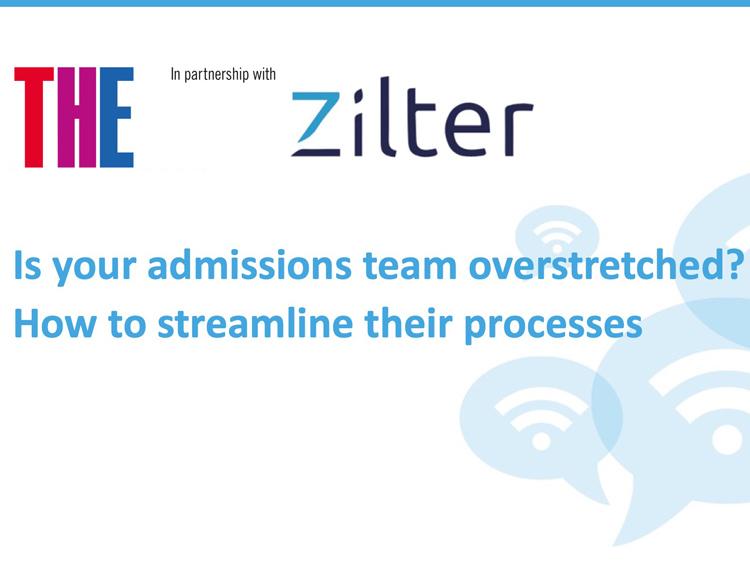
A guide to making automation work in higher education
Implementing automation in universities can relieve staff from repetitive tasks, streamline operations and enhance the student experience. Find out how to do it and the key questions to ask at each stage

Imagine recruiting a team that takes on the repetitive, high-volume, low-value tasks that often overwhelm your staff. Imagine if that team could also reduce errors, eliminate backlogs and work 24/7 – seamlessly integrating into your service model, saving time and streamlining operations. By embracing Intelligent Automation, this vision is within reach.
Through automation, universities can lay a solid foundation for future AI-driven solutions. Here, we explore how automation – specifically Robotic Process Automation (RPA) – can reshape university operations, streamline processes and enhance experiences for both students and staff.
Why automation?
UK universities are under pressure to deliver top-tier services in an increasingly digital-first world. As resources become stretched and student expectations rise, automation presents a valuable solution. By reducing administrative burdens, universities can streamline processes and empower staff to focus on more impactful student engagement and academic support.
- AI as a catalyst for assessment innovation
- THE Awards 2024 spotlight: learn from the best in UK and Irish higher education
- Could AI manage your research project?
At the University of Glasgow, we began our automation journey with these aims in mind. While we encountered some challenges, the rewards have been worth it. Our experiences may offer insights for other institutions considering automation as a tool for enablement and future readiness.
Setting clear goals and engaging stakeholders
To succeed with automation, start by setting clear goals that align with institutional strategy. Our mandate is focused on removing repetitive tasks from processes to boost efficiency and effectiveness. Early goal-setting helped us gain consensus and create a shared vision for automation’s role.
Stakeholder engagement from the outset is essential, because automation impacts many departments. We partnered with teams across the university and maintained open communication with trade unions and key enablers such as those in IT, data protection and academic policy. We framed automation as a tool for support, rather than replacement, and involved stakeholders in design and compliance discussions.
A human-centred approach helped us build trust and set a collaborative tone for the service. Humans at the centre is baked into everything we do and we take colleagues with us along the automation journey.
Key considerations for starting your automation journey
Why automation? Define a clear vision and purpose for your automation project. Identify specific goals to ensure that your efforts align with broader institutional objectives.
What to automate? Automation isn’t a blanket solution. Carefully select tasks that are suited to automation while understanding which areas may require other solutions.
Value beyond savings: Time and cost savings are just the start. Automation can also drive significant transformation across teams, enhancing efficiency and service quality.
Consider user experience: Plan for unintended consequences. Consider how automation impacts the experience for students and staff, using it to enhance interactions rather than merely replacing tasks.
Tackling data and process ownership challenges
One of our main challenges was the lack of data and clear process ownership. With limited established baselines or data practices, it was hard to measure automation’s impact. In some departments, process ownership was ambiguous, which made it difficult to standardise and automate processes effectively.
To address this, we collaborated with departments to digitise records and established baselines using available data. This required a creative approach, drawing from sources such as email records and help desk data. Automation can drive mindset shifts by encouraging departments to identify process owners and invest in data collection practices. By doing so, universities can prepare for more advanced technologies and ensure effective service delivery.
Critical questions on data readiness and process ownership
What are the baselines? Even limited data can provide a starting point. Establish baselines early to track progress and assess impact.
Who owns each process? Assigning process ownership from the start is vital for accountability and continuous improvement.
Are processes standardised? Look for variability in how different departments handle the same tasks. Automation offers an opportunity to standardise processes, maximising efficiency and value.
Addressing security and business systems
Information security is crucial, especially when handling sensitive data. Early collaboration with IT and data protection teams ensured compliance and accessibility. Our reliance on business systems presented another challenge because these don’t always integrate with automation tools. By working closely with system owners and leveraging APIs where possible, we bridged some of these gaps with an aim of minimising technical debt.
Key steps for security and business systems
Prioritise security: Involve specialists early on to establish secure protocols for handling data.
Plan for business systems: Assess system compatibility in advance and aim to design solutions that reduce technical debt
Building long-term support and resilience
While automation projects can deliver impressive results, benefits may take time to materialise, and ongoing investment is necessary. We secured long-term support by presenting regular impact reports and demonstrating value. Showing how automation saved staff time and improved service quality helped us work with departments to demonstrate the value of automation.
Instead of relying on external support, we chose to build an internal team, which ensures resilience and long-term flexibility. This approach reduces costs and ensures we retain expertise to continue evolving with intelligent automation.
Ensuring ongoing support and building in-house expertise
Demonstrate value continuously: Regular updates with metrics and impact reports help justify ongoing investment and secure leadership support.
Develop internal capacity: Build a capable internal team to maintain flexibility, avoid dependency on costly external support and enhance institutional knowledge.
Transforming university operations with automation
Automation has already transformed many processes at the University of Glasgow. At time of writing, we have delivered 25 virtual workers across 15 departments, saving the equivalent of more than 20,000 hours in working time, as well as delivering benefits including cost avoidance, risk avoidance, improved compliance, reductions in waiting times and improved experience.
The long-term vision for automation is that it becomes an integral part of what we do at the university, helping eliminate the manual and repetitive processes across the institution. The benefits are wide: for our professional services staff, who have time back to focus on more value-add activity and moving their work higher up the value chain.
For our academic staff, again, time back and an opportunity to focus more on the core activities of research and teaching. For those receiving services, automation can enhance the experience by providing more consistent service, reducing waiting times and ultimately creating a smoother, more satisfying process.
Moving forward with automation
Automation is an ongoing journey. Success in this area requires flexibility, collaboration and adaptability. With thoughtful planning and a willingness to adjust, other universities can harness automation to enhance operations and create a positive impact for students and staff.
Steps for success
- Have a clear vision, define goals and engage stakeholders from the start
- Choose compatible tools, use pilots first and work in partnership with specialist teams
- Build a dedicated team and invest in their training and upskilling
- Address data and process ownership challenges
- Ensure security and plan for business systems
- Capture and share the benefits and value that automation enable
We hope that by sharing the lessons we’ve learned and offering practical steps, others can also navigate the complexities of automation.
Gregor Caldow is executive director of finance and automation executive sponsor and Jennifer Robertson is head of automation, both at the University of Glasgow. They were shortlisted in the Technological or Digital Innovation of the Year category in the 2024 THE Awards. A full list of nominees can be found here.
If you would like advice and insight from academics and university staff delivered direct to your inbox each week, sign up for the Campus newsletter.


